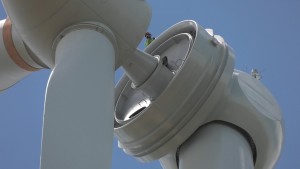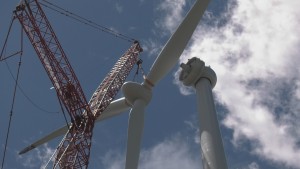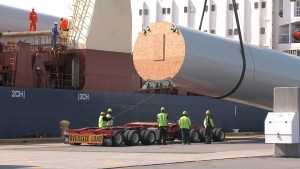 It was not a job for anybody with a fear of heights. More than 400 feet up, workers headed into the homestretch assembling a 1.5 megawatt wind turbine in western Coventry. A crane operator on the ground and a supervisor at the top worked together to maneuver the blades into place. Each blade weighs nine tons and measures 134 feet. The fit has to be exact.
It was not a job for anybody with a fear of heights. More than 400 feet up, workers headed into the homestretch assembling a 1.5 megawatt wind turbine in western Coventry. A crane operator on the ground and a supervisor at the top worked together to maneuver the blades into place. Each blade weighs nine tons and measures 134 feet. The fit has to be exact.
Last month, three turbines began providing all of the electricity the town of West Warwick will need to power its municipal buildings. The town’s taxpayers last year authorized borrowing $18 million to buy the three turbines.
Wind Energy Development and its owner Mark DePasquale is building a 10-turbine wind farm in Coventry. DePasquale also put up a replacement turbine at the site in Portsmouth where failed equipment sat idle for years. He’ll soon begin selling electricity to the town.
 The Narragansett Bay Commission, which in 2012 put up three of its own turbines on the Providence waterfront, purchased another three in Coventry from Wind Energy Development, putting the Bay Commission well toward its goal of using entirely renewable energy for the agency’s power needs.
The Narragansett Bay Commission, which in 2012 put up three of its own turbines on the Providence waterfront, purchased another three in Coventry from Wind Energy Development, putting the Bay Commission well toward its goal of using entirely renewable energy for the agency’s power needs.
We first reported on the Coventry project earlier this year, when the company was laying the foundations for what would eventually be last month’s finished product.
It hasn’t been the smoothest road for DePasquale — he faced resistance from National Grid and rode out numerous delays to get to where he is today. Critics doubted whether DePasquale could succeed at a land-based project this size, the first of its kind and scope in Rhode Island.
 “We needed to prove to National Grid that we can work with them and create a system,” DePasquale said. “We sited the turbines responsibly and we had to show people that the economics do work and it’s a safe way to manufacture electric. We’re harvesting wind and making electric.”
“We needed to prove to National Grid that we can work with them and create a system,” DePasquale said. “We sited the turbines responsibly and we had to show people that the economics do work and it’s a safe way to manufacture electric. We’re harvesting wind and making electric.”
DePasquale has been a quick study on wind energy. He put up his first turbine next to his own house in North Kingstown in 2010. He has since visited other wind farms and traveled to Germany where the manufacturer, Vensys, is based.
Germany is where a shipment came from when it arrived in June at Quonset Point. The major components of 11 turbines came by ship. Each piece was unloaded and later staged in another part of the park, then moved, in the middle of the night, out to Coventry. We watched throughout the summer the delicate process of attaching blades to the nacelle that houses them. The first turbine took nearly two days to assemble. After that the construction moved more quickly.
 “Once you get a real vision of where to put the components, where to set, what’s the next move, it’s complicated, it’s technical, but it’s fairly routine,” DePasquale said. “After you get the first one, everything follows the same.”
“Once you get a real vision of where to put the components, where to set, what’s the next move, it’s complicated, it’s technical, but it’s fairly routine,” DePasquale said. “After you get the first one, everything follows the same.”
The final stage of construction began with the crews fastening straps on the blades that allowed the crane to hoist the assembly to its final position.
“Probably the hardest part of the project is getting the blades parallel with the tower,” DePasquale said. “The team’s very skilled, the team in the air is skilled, the crane operator has to be very precise because you have men inside. What’s difficult is you have over 150 studs, which are screws — let’s call them — that have to line up with the holes exactly. So when you lift it off the ground, you have to pitch the turbines a little bit to line it all up.”
After the turbines went up there were six weeks of fine tuning. Ironically, before the turbines can generate power that will go back into the system, National Grid has to energize the equipment to turn it on initially. That fires up the computers and allows the blades to be tested.
After 500 hours, crews will shut the turbines down temporarily and go in to check the components — literally the nuts and bolts.
DePasquale says he would like to see standard guidelines for wind projects. The head of the Rhode Island Office of Energy Resources tells The Hummel Report her office hopes to have those guidelines out by the end of the year.
“Do we want a farm with 100 acres of solar panels on it when I can produce the same energy with three turbines? You know those are the things they need to decide. It’s uncharted waters (for the state). I think they’re following and watching and I think everybody wanted to see what happened. And I think the jury’s out right now and we’ve got to see what happens.”
The Hummel Report is a 501 3C non-profit organization that relies, in part, on your donations. If you have a story idea or want make a donation go to HummelReport.org, where you can also see the video version of this story. You can mail Jim directly at Jim@HummelReport.org.


